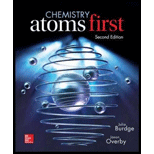
Interpretation: Would the metal alkoxide in sol-gel process be acidic or basic has to be justified
Concept Introduction:
Ceramics are
Ceramics are hard and have high melting points. They are heat insulators.
Ceramics have partly crystalline or cystalline or amorphous structure.
Example: Glass
Ceramics was prepared by a process called sintering. The resulting product was irregular in shape with cracks, spaces and imperfections. Hence, sol-gel method was employed to prepare ceramics of uniform size without much of cracks and gaps.
Want to see the full answer?
Check out a sample textbook solution
Chapter 24 Solutions
Chemistry: Atoms First
- Is bis(oxalato)platinate(II) a diamagnetic square planar complex? Yes or no? How about at the start of an electrochemical reaction, is the cell potential (Ecell) of a concentration cell always zero? Yes or no?arrow_forwardDescribe the periodic trends in radii and oxidation states of the transition-metal ions, including the origin and effect of the lanthanide contraction.arrow_forwardThe ionization constant Ka for nitrous acid is 4.6x10⁻⁴. What are the the pKa for nitrous acid and the pH of a 0.1 M solution of this weak acid?arrow_forward
- What is the process of making chlorine from the electrolysis of sodium chloride called? chlor-alkali process electrolysis reduction oxidation Which of the following ligands has the weakest field strength? Br- C2O42- NH3 NO2- What common acid will react with silicon dioxide? hydrofluoric acid hydrochloric acid sulfuric acid nitric acid What holds the layers of graphite together? London dispersion forces Hydrogen bonds dipole-dipole forces Ionic bonds Which of the following noble gases can form stable compounds? Xenon Krypton Argon Helium Why are group 12 elements considered representative metals? The last electron is an s electron They do not have d electrons The d electrons move to the s shell none of thesearrow_forwardWhat is Lanthanoid contraction? What are its two consequences?arrow_forwardUnder what conditions is the FeO42- ion thermodynamically stable in aqueous solution?arrow_forward
- Why is it important to exclude water when preparing Bis(Pyridine) Iodine (I) Nitrate complex.arrow_forwardIn the iron (II)-silver ion system performed in the experiment, all of the following successfully confirmed that each of the chemical species is present in the system EXCEPT. -Formation of white precipitate when HCl was added in the system -Deposition of silvery solids when FeSO4 and AgNO3 were mixed together -Formation of dark blue solution when K3Fe(CN)6 was added in the system -Transformation of pale orange to solution into a blood red solution when KSCN was added in the systemarrow_forwardDescribe the principle behind each of the following processes: (i) Vapour phase refining of a metal. (ii) Electrolytic refining of a metal. (iii) Recovery of silver after silver ore was leached with NaCN.arrow_forward
 Principles of Modern ChemistryChemistryISBN:9781305079113Author:David W. Oxtoby, H. Pat Gillis, Laurie J. ButlerPublisher:Cengage Learning
Principles of Modern ChemistryChemistryISBN:9781305079113Author:David W. Oxtoby, H. Pat Gillis, Laurie J. ButlerPublisher:Cengage Learning Chemistry: The Molecular ScienceChemistryISBN:9781285199047Author:John W. Moore, Conrad L. StanitskiPublisher:Cengage Learning
Chemistry: The Molecular ScienceChemistryISBN:9781285199047Author:John W. Moore, Conrad L. StanitskiPublisher:Cengage Learning

